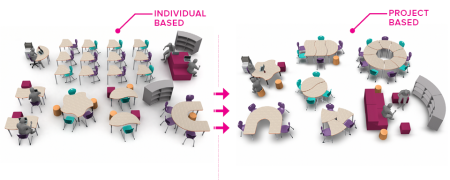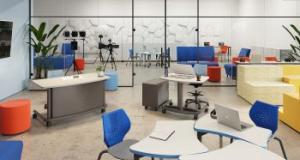Classroom transitions are proving increasingly trickier as room sizes shrink but student populations do not. This results in an increasing number of “legs”—eight per student, including both desk and chair – leading to potential trip hazards and limited flexibility. This shift requires a fresh approach to optimizing classroom space and prioritizing movement for students and staff alike. By specifying furniture that supports adaptable learning environments, educators now have the tools to create multiple options on how to move from one setting to another, all while minimizing wear and tear on the interior built environment.
According to Artcobell, a leading furniture manufacturer in the K-12 education facility space Director of Design, Nicki Heiner “typically, when we find a space planning layout our clients like, we will also show them two or three ways that they can use the same kit of parts to achieve different configurations,” Heiner said. The easier we show them how to make those transitions, the more likely they are to use them, keeping students invested and engaged in their learning.
Whether you’re simply curious about playing with the “front” of the room, or planning for larger scale turnovers between collaborative small groups to instructional forward-facing groups, here are five product specifications and design considerations that will certainly make for a fun and effective learning environment.

- Think Outside the Shape Box
Heiner suggests avoiding anything that takes a large footprint when it comes to furniture selection—for instance, larger expensive horseshoe-shaped tables that only get used for a short amount of time. Stick to modified horseshoes utilizing the student desks. In turn this will open up the space for more movement as well as free up funds to add in more flexible seating options such as movement stools, rockers, or soft seating.
Consider desks without the traditional rectangle surface. “Educators can be apprehensive about or get scared by organic shapes at first. Show them how easy it is to create fun groups of two, three, four or even five,” Heiner explained.
- Look Up, Down, Side-to-Side
Welcome the 360-degree classroom.
“Not only is it good to have a variety of seating options, but also a variety of heights, especially in the lower grades.” Think stations throughout the room for standing, seated, and floor work. As you move into middle and high school, this can evolve into more of a leveled, tiered system mix of seated, counter stools and bar stools, to soft lounge seating.
“Eyes forward” is also a phrase of the past as many districts now want teachers up, moving, and constantly engaged with their students. This movement coupled with the integration of flexible, mobile desking and seating allows students to turn and follow their instructor—even in that modified horseshoe shape—as they move about and through various lesson types.
- Mobility Equals Autonomy
Heiner advocates for the “wheelbarrow” model, incorporating two casters on desks and tables. This design enables students to easily lift and reposition furniture as needed, promoting flexibility in the classroom. Additionally, utilizing casters supports facility staff by simplifying movement during cleaning and maintenance.
Encourage using smaller desks for instructors, paired with mobile storage units and podiums that make traveling around the room easy. Many schools are now removing built-in millwork and cabinetry Heiner reports, in favor of this. “Cabinets flex with the room, allowing the teacher to set up a different way one day, or use that storage as a separation of space and you’re not stuck to one particular layout.”
- Tech-Conscious
When designing and specifying remember that technology develops at speeds we can never match, so avoid strict tethering as much as possible. Flexible power access is key. This is most difficult in computer labs where visual access to the front of the room is necessary, yet tables and chairs traditionally are positioned to face the wall outlets.
Teachers need “non-handed” desks that allow the user to switch components to the opposite side if power access is blocked. For students, try not to embed ports in a table, but rather use products that are rechargeable and can be placed on top, or moved around the room on a stand or a cart. Wire management is also a challenge below the worksurface, so be conscious of a table’s undercarriage for wire storage. Avoid drilling holes in a table to tackle this, as needs may change over time. “The use of a surface clamp-on convenience power outlet provides worksurface access to power without damaging the table or desk but you’re not having to crawl under the table to get it,” Heiner suggested.
- Bet on Durability
Not only will all of the above achieve smoother classroom transitions, but all options help maintain the quality of the interior.
- Utilize casters on tables instead of glides to help preserve the rooms flooring.
- Look for worksurfaces featuring HPL (high impact laminate) and PVC-edge banding to stand up to the daily use and abuse of table and desktops.
- Avoid selecting light or pale colors of finishes which tend to show dirt and marks easily.
- Specify highly durable soft seating upholsteries that are bleach-cleanable and have a high double rub count of 250,000+. Recommended fabric types to specify on furniture for school environments are vinyls and polyurethanes that meet these criteria.
Most importantly, remember it doesn’t have to be an all or nothing approach. “The smallest shifts in the room can create a whole different atmosphere,” Heiner reminds us. Identifying your client’s priorities will give you the clearest path forward in providing learning environments that grow and evolve as easily as young minds do!

